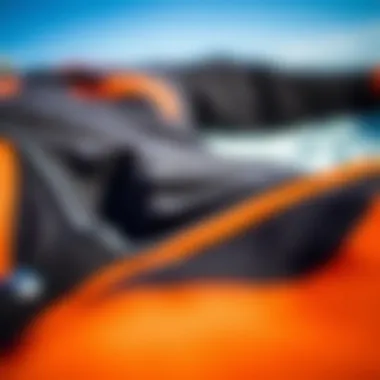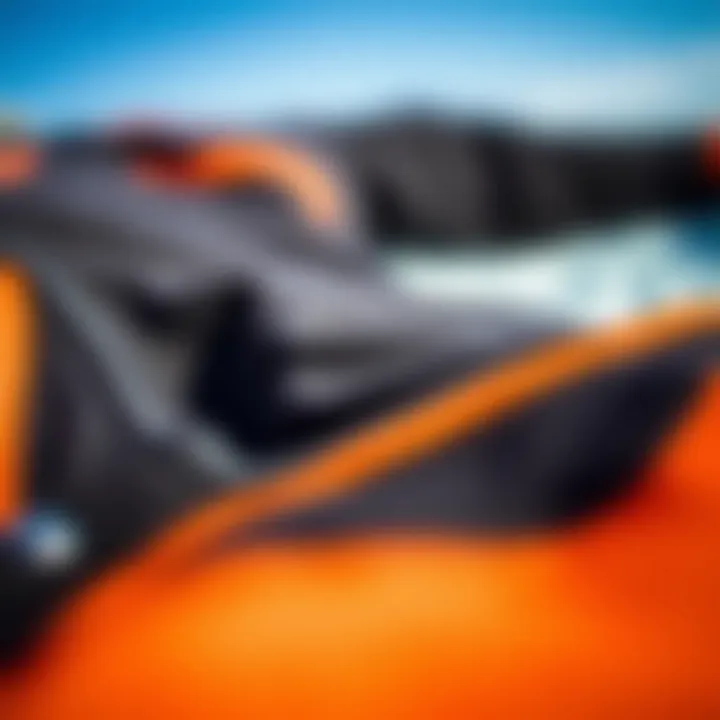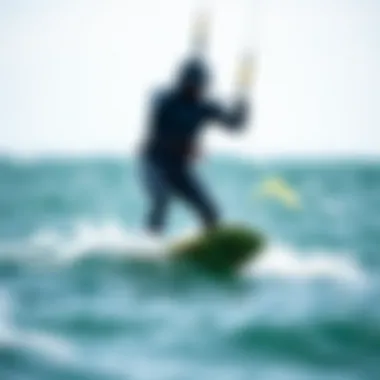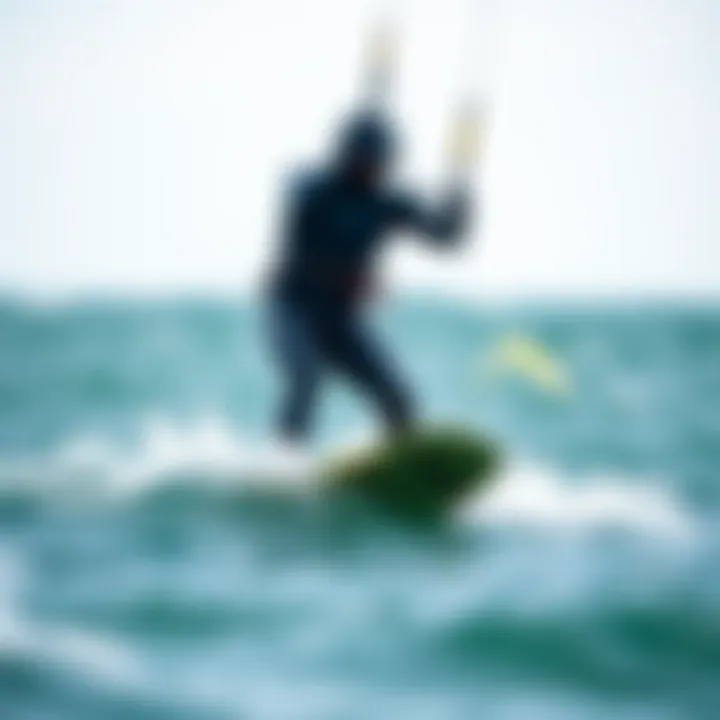Choosing Wetsuits for Cold Water Kiteboarding


Intro
Kiteboarding in cold water is an experience that continues to draw enthusiasts, yet it poses unique challenges that require proper preparation. A significant aspect of this preparation lies in the selection of a suitable wetsuit, specifically designed to keep you warm in frigid conditions. Unlike your run-of-the-mill wetsuits, cold water options provide better insulation, flexibility, and enhanced protection against the elements. Favoring the right wetsuit is paramount; it could mean the difference between enjoying exhilarating rides and shivering through the cold.
This article breaks down the specifics of cold water wetsuits, ensuring kiteboarders—whether new to the sport or seasoned pros—understand what to look for in their gear. From the essential materials that make up a quality wetsuit to fitting advice that keeps comfort levels high, every detail is designed to provide you with the insights needed to enhance your kiteboarding experience.
Let’s dive into the essentials.
Equipment Insights
Latest Gear Reviews
When it comes to cold water kiteboarding, not all wetsuits are created equal. There are some top contenders making waves in the industry. For instance, the O'Neill Psycho Tech is often praised for its advanced thermal layer and stretch technology. Its seamless design not only keeps water out but also enables maximum freedom of movement, crucial for executing tricks.
The Xcel Drylock wetsuit is another remarkable option. Its unique, innovative features—like the thermo-bamboo lining—provide warmth without extra bulk, making it easier to maneuver while riding the waves. With features tailored for extreme conditions, these brands really have their eyes on kiteboarders’ needs.
Essential Gear Maintenance
Keeping your wetsuit in top-notch shape isn’t just a matter of rinse and repeat.
- Rinse After Each Use: Freshwater rinse is vital to extend the life of your wetsuit. Salt and sand can deteriorate the material over time.
- Dry in Shade: Sunlight can be harsh on neoprene, causing it to degrade. Always hang your wetsuit in a shaded area to dry, avoiding direct sunlight.
- Use a Wetsuit Shampoo: Once in a while, treat your wetsuit with a specially formulated wetsuit shampoo to remove any embedded dirt and odors.
Taking these steps helps ensure your wetsuit remains functional and comfortable, so you can stay focused on your kiteboarding experience rather than struggling with equipment issues.
>"Proper care of your wetsuit can increase its lifespan significantly. Treat your gear well, and it will treat you well in return."
Choosing the Right Size and Fit
Getting the fit right is almost as important as the materials used. A wetsuit that's too loose will let cold water seep in, while a suit that's too tight can restrict movement and become uncomfortable.
- Chest Measurement: This determines how snugly your wetsuit will fit around your torso.
- Inseam Measurement: This ensures the legs of the wetsuit aren’t too short nor too long.
- Neck Opening: Look for suits with adjustable neck seals, which can help to reduce water entry even further.
All these factors contribute to both your comfort and thermal regulation, enabling you to ride longer and more effectively in less-than-ideal conditions. A well-fitted wetsuit acts like a second skin, giving you the confidence to push your limits.
Stay tuned as we further explore various aspects of cold water kiteboarding gear, as well as techniques that enhance your experience on the water.
Understanding Wetsuits for Cold Water
Kiteboarding in cold waters can be one thrilling experience, but without the right protection, it can also be unforgiving. Selecting a wetsuit tailored for cold water is not just about staying warm; it's about enhancing your overall performance and comfort on the water. In this section, we will explore the significance of understanding wetsuits meant specifically for colder conditions, delving into elements that should not be overlooked by kiteboarders.
The Importance of Wetsuits
Wetsuits serve as a vital piece of gear that provides insulation against the biting cold of chilly waters. When you're out there, time seems to stand still, but a dip can quickly turn into a shivering affair without proper thermal protection. Cold water can sap your energy rapidly, leading to fatigue and impairing your ability to maneuver on the board. Thus, wearing a good-quality wetsuit doesn't just keep you warm; it keeps you in the game longer.
Moreover, a wetsuit helps in buoyancy, making it easier to float and potentially reducing the risk of hypothermia—something no kiteboarder wants to grapple with. Opting for the right wetsuit significantly enhances your confidence while you ride those waves.
Cold Water vs. Warm Water Wetsuits
Understanding the contrast between cold water wetsuits and warm water variants is crucial for any kiteboarder looking to make an informed choice. Cold water wetsuits are generally thicker—usually ranging from 4mm to 6mm—compared to warmer suits, which might be just 2mm to 3mm.
For cold conditions, insulation is the name of the game. Features like sealed seams and greater thermal efficiency are standard in these suits. Meanwhile, warm water wetsuits prioritize flexibility over insulation as the need for warmth isn't as acute in balmier environments. Such differences highlight the importance of selecting suits designed for specific water temperatures.
In cold water, even the lightest breeze can make it feel several degrees cooler, so wearing an adequate wetsuit is an outright necessity rather than a luxury. Understanding these essential distinctions will assist kiteboarders in making purchases that ensure not only comfort but also enhances their riding experience, allowing them to focus better on their skills and enjoy the thrill of the ride.
"The right wetsuit can turn a freezing session into a comfortable ride, making every venture out on the waters a pleasure rather than a chore."
Choosing the right wetsuit tailored for cold water conditions is an investment in your kiteboarding journey, ensuring both safety and performance remain at the forefront of each ride.


Key Features of Cold Water Wetsuits
When it comes to kiteboarding in colder climates, selecting the right wetsuit can make all the difference between a thrilling ride and a less enjoyable experience. Cold water wetsuits come equipped with distinctive features that address the unique demands of frigid waters while keeping the wearer both warm and agile. Understanding these key features is paramount for enthusiasts, instructors, and anyone who revels in the windy experience of kiteboarding.
Thickness and Insulation
Thickness is one of the most critical aspects of any wetsuit, especially for cold water kiteboarding. Generally, cold water wetsuits range in thickness from 4mm to 6mm, depending on the water temperature. A wetsuit that's too thin won't provide adequate insulation, leading to rapid heat loss and potentially hypothermia. Conversely, a wetsuit that's overly thick can limit mobility, making it difficult to ride effectively. The secret is striking that perfect balance.
Insulation technology has also evolved. Modern wetsuits may feature strategically placed layers of thermal material that enhance warmth without adding bulk. One such innovation is the use of titanium-coated neoprene, which reflects body heat while still allowing for flexibility and movement.
"Choosing the right level of thickness can feel like balancing on a tightrope. Too thin, and you're sinking; too thick, and you're hardly moving."
Neoprene Quality
Not all neoprene is created equal. The quality of neoprene determines not just warmth but also durability and comfort. High-end wetsuits often utilize closed-cell neoprene, which is denser and provides better insulation. This type of neoprene resists water absorption, meaning it stays lighter and warmer during extended sessions.
In contrast, cheaper wetsuits may use lower quality materials that wear down more quickly or allow water to seep in, drastically reducing their effectiveness. Some brands are even incorporating eco-friendly neoprene made from limestone to reduce their environmental footprint. This aspect may appeal to environmentally conscious kiteboarders who wish to make sustainable choices without sacrificing quality.
Seam Construction
Even the best neoprene won't protect you from the cold if the seams aren't constructed properly. The way seams are stitched together can either enhance comfort and insulation or invite cold water in. There are generally three types of seam constructions: flatlock stitching, blind stitching, and tape seams.
- Flatlock stitching is common but tends to allow more water in, making it more suitable for warmer conditions.
- Blind stitching is a step up; it penetrates only partially, minimizing water entry while maintaining flexibility.
- Taped seams are the gold standard in warmth and durability, often found in higher-end models. They use a special tape applied over the seams, blocking water and increasing the suit’s longevity.
Each of these seam types serves a specific purpose and is best suited for different conditions. Riders should evaluate their local weather and water temperatures to determine which seam construction aligns with their needs.
In summary, the features of cold water wetsuits serve as fundamental pillars for kiteboarders looking to thrive in less hospitable conditions. Thickness, neoprene quality, and seam construction are not just technical specifications; they significantly influence performance and comfort in the water. Understanding these attributes can lead to better decisions and improved experiences during every kiteboarding adventure.
Choosing the Right Size
When it comes down to kiteboarding in cold water, one of the first, and most vital, decisions kiteboarders must make is to select the correct wetsuit size. A well-fitting wetsuit not only keeps you warmer but can also impact your overall performance on the water. If you end up in a suit that's too tight, movement can feel restricted. On the other hand, if it’s too roomy, cold water can seep in and ruin your ride.
Measuring for Fit
To find your perfect fit, it all starts with taking your measurements accurately. Here are the most common measurements you should consider:
- Chest Size: Measure around the broadest part of your chest.
- Waist Size: Measure at your natural waist, which is usually just above your navel.
- Hip Measurement: Measure around the fullest part of your hips.
- Inseam: Measure from the top of your inner thigh down to your ankle.
- Torso Length: Measure from your shoulders to your groin to give a clear idea of the suit length needed.
Once you have your measurements, it’s best to consult the size chart of the wetsuit brand you’re considering. Every brand has its own sizing standards, and what fits you in one brand might not translate to another.
Common Fitting Issues
Even with careful measuring, kiteboarders often run into fitting issues. Here are some common problems to look out for:
- Tight Shoulders: If the suit feels restrictive in the shoulders, you may struggle to paddle or move effectively.
- Excessive Space: If there’s space between your body and the suit, it can result in water pooling in the wetsuit, leaving you cold and uncomfortable.
- Restrictive Ankle or Wrist Openings: These should fit snugly but allow for ease when getting in and out. Too tight can restrict circulation.
- Torso Length: An overly long torso can lead to sagging material and gaping at the knees.
- Overall Length: The suit should feel comfortable when you are standing, but it will likely feel a bit tighter when you sit down to kiteboard. Test how it feels when you are in your kiteboarding position.
Remember that some brands incorporate flexible designs that cater specifically to kiteboarders’ movements. Despite the potential for issues, getting the right size does significantly enhance your experience, increasing both comfort and performance while you're out tackling the waves.
For more about choosing the right wetsuit sizes, you might find useful resources on Encyclopedia Britannica or Wikipedia.*
Materials Used in Cold Water Wetsuits
Understanding the materials utilized in cold water wetsuits is vital for kiteboarders aiming to maintain warmth and flexibility in frigid conditions. The right material not only ensures comfort but also significantly impacts your performance on the water. It's all about finding the ideal balance between insulation and mobility.
Types of Neoprene
Neoprene is the star player in cold water wetsuits, but it’s not all created equal. There are several types, each serving a specific purpose.
- Standard Neoprene: The classic choice. Offers decent warmth and flexibility, but it can weigh you down after prolonged use in water.
- Cressi Neoprene: Known for its durability and proper thermal insulation. This material provides excellent padding, a necessary feature for chilly day kiteboarding.
- Super Stretch Neoprene: If you’re seeking maximum flexibility, look no further. This type allows for a snug fit without restricting movement, essential for high-energy activities like kiteboarding.
- Yamamoto Neoprene: Made from limestone rather than petroleum, this eco-friendlier option boasts superior thermal insulation. It’s also significantly lighter, which can be a godsend once you’re out on the waves for hours.


While it might be tempting to grab the cheapest option, investing in quality neoprene can dramatically influence your experience. The thickness often varies between 4mm and 6mm for cold water, and thicker won’t always mean better. A comfortable fit is the secret sauce.
Alternative Insulating Materials
There’s a growing trend toward alternative materials in wetsuit manufacturing. Not only do these provide warmth but they also aim for a more sustainable approach.
- Merino Wool: A natural fiber that’s thermoregulating and super comfy. While not traditionally used as the main insulation, it’s becoming popular in linings for an added layer of warmth without the weight.
- Thinsulate: Widely recognized for its insulating properties, this lightweight material is often blended with neoprene to enhance warmth without sacrificing flexibility.
- Cork: Yes, you read that right! Some brands are experimenting with cork, which can provide buoyancy alongside its insulating ability. It’s a fresh take that’s worth keeping an eye on.
"Choosing the right materials in your wetsuit can be the difference between enjoying a session on the water or cutting it short due to the cold."
When selecting your cold water wetsuit, considering modern materials can make all the difference. Always remember to prioritize comfort, thermal insulation, and the environmental impact of your gear. The right wetsuit can elevate your entire kiteboarding experience, allowing you to focus on mastering those waves, rather than shivering through your session.
Innovations in Thermal Technology
In the realm of cold water kiteboarding, the innovation in thermal technology has become paramount. Kiteboarders often brave chilly conditions, necessitating advanced wetsuit designs that not only safeguard against the cold but also enhance performance. Today’s wetsuits incorporate cutting-edge technologies that prioritize insulation, comfort, and mobility, allowing riders to focus on their skills rather than their temperature. These innovations can make all the difference when you're out there riding the waves, especially in frigid waters.
Smart Wetsuit Solutions
Modern wetsuits have embraced the age of technology with smart features that cater directly to active water sports enthusiasts. Smart wetsuit solutions integrate elements such as IoT (Internet of Things) sensors, which monitor body temperature and respond to changes in real-time. This means that the suit can adjust insulation properties on the fly, ensuring optimal warmth without overheating.
- Temperature Sensors: These sensors can alert the wearer if they begin to cool down too much, providing peace of mind during extended sessions on the water. A notable feature is connectivity to mobile devices, allowing kiteboarders to track their heat levels and make necessary adjustments while in action.
- Heating Elements: Some advanced models come equipped with battery-powered heating elements that can be activated in particularly frosty conditions. This can be a game-changer for those long, intense rides that might otherwise leave you shivering.
- Reflective Linings: Smart wetsuit products also explore reflective linings that direct heat back to the body, an innovative approach that maximizes warmth. This means you stay cozy while still having the flexibility to maneuver on your board.
Thermal Linings
The thermal lining of a wetsuit acts as its protective barrier against the cold, providing essential insulation without compromising flexibility. With advancements in materials, the thermal linings found in today’s wetsuits play a crucial role in ensuring that kiteboarders keep their edge on cooler days.
- Types of Linings: Many brands have developed proprietary thermal linings designed for maximum warmth. These materials offer varying levels of insulation and breathability, giving kiteboarders options that suit their particular needs.
- Quick-Drying Properties: The effectiveness of thermal linings is also linked closely to their ability to dry quickly. A wet lining can sap away warmth, making it vital that a wetsuit's interior dries fast. Innovative textiles are now engineered to reduce water retention, which is beneficial during multi-session days.
- Comfort and Fit: Beyond insulation, thermal linings need to provide comfort. Advances in fabric technology result in softer materials that feel better against the skin and allow for greater movement. When a kiteboarder is comfortable, they can concentrate on making the most of their time on the board.
In summary, innovations in thermal technologies are reshaping the experience for kiteboarders in cold water environments. These advancements not only increase comfort but also enhance performance and safety on the water. As the market continues to evolve, the relationship between technology and wetsuit design will play an increasingly indispensable role in the kiteboarding landscape.
Brands to Consider
Selecting the right wetsuit is not just about finding the right fit; it’s about choosing a brand that stands behind its product. The market for wetsuits, particularly for cold water kiteboarding, is teeming with choices, and understanding which brands to trust can make a significant difference in your riding experience. A reputable brand often means better design, quality materials, and customer support. Let's explore some of the leading names and emerging players in the wetsuit arena.
Leading Market Players
When it comes to cold water wetsuits, several companies have established themselves as the go-tos for kiteboarders. These brands not only deliver on performance but also on reliability.
- O’Neill: A long-time leader in the wetsuit industry, O’Neill is known for its innovative designs and high-quality neoprene. Their cold water range, particularly the Psycho series, is tailored for warmth and flexibility, making it a favorite among athletes.
- Rip Curl: Another stalwart, Rip Curl provides exceptional insulation combined with a lightweight feel. Their Flash Bomb line features rapid-dry technology, which is highly beneficial for those wet and windy days on the water.
- Billabong: Known for stylish designs and robust functionality, Billabong's wetsuits often blend fashion with performance. Their Furnace range emphasizes thermal retention without compromising flexibility, making them ideal for kiteboarders seeking comfort in cold waters.
- Mystic: A brand that has gained popularity in recent years, Mystic stands out with its focus on the kiteboarding community. They offer various products that cater exclusively to kiteboarders, combining a chic aesthetic with performance.
These companies have a long history in the sport, and their continued research and development make them reliable choices. Most importantly, their commitment to using high-quality materials and technologies means you’re counting on proven functionality.
Emerging Brands Worth Noticing
While established brands dominate the market, several up-and-coming players are worth keeping an eye on. They often introduce fresh ideas and approaches to wetsuit design, which can lead to exciting innovations.
- Futures: This relatively new brand is gaining traction for its focus on eco-friendly materials. They emphasize sustainability without compromising performance, making their wetsuits a great choice for environmentally conscious kiteboarders.
- Dryrobe: Uniquely, Dryrobe focuses on changing robes and outerwear designed for aquatic sports enthusiasts. Their products are not traditional wetsuits, but they offer exceptional thermal protection when you’re out of the water, making them a complementary piece in a kiteboarder’s kit.
- Vissla: With a stylish approach and a commitment to sustainability, Vissla’s wetsuits are crafted from innovative materials that provide warmth while being gentle on the planet. Their designs appeal to a younger audience who values both performance and eco-responsibility.
In considering these emerging brands, kiteboarders can find options that not only meet their performance needs but also align with their personal values, whether that’s sustainability or a unique style.
In summary, the right brand can significantly impact your cold water kiteboarding experience. It’s not merely about the product, but the trust you place in the company behind it. Always research and consider what each brand stands for, as well as what they offer in terms of warranty and customer service.
The exploration of these brands ensures that kiteboarders, whether seasoned pros or newcomers, have ample choices when it comes to selecting a wetsuit that will keep them warm and performing at their best.
Maintaining Your Wetsuit
Keeping your wetsuit in top shape is not just about prolonging its lifespan; it's essential for maintaining your performance and comfort in cold water kiteboarding. A well-maintained wetsuit prevents issues like leaks, discomfort, and even skin irritations. Plus, it ensures that the insulating materials retain their effectiveness, keeping you warm when the temperatures dip.
Cleaning and Care Tips


First things first, rinsing your wetsuit is a must after each use. Saltwater, sand, and chlorine from pools can wear down the neoprene over time, leading to less flexibility and insulation. After you finish your session, soak the wetsuit in fresh water for about 15 to 20 minutes to wash off any residue. Here are some specific steps you can follow:
- Rinse: Always rinse your wetsuit inside and out with fresh water. This will help remove salt and other additives that can break down the materials.
- Gentle Wash: Use a wetsuit-specific cleaner if you need a deeper clean. Regular soaps can be harsh and might degrade the neoprene.
- Drying: Avoid direct sunlight when drying your wetsuit, as UV rays can deteriorate its elasticity. Instead, hang it upside down to allow water to drain out completely.
- Avoid Heat: Never put your wetsuit in a dryer. The heat can warp the neoprene and compromise its insulation.
- Inspect: Regularly check for any signs of wear, including rips or weak seams, so you can address issues before they become major problems.
"A little care goes a long way; your wetsuit will thank you later!"
Storage Considerations
Proper storage of your wetsuit is just as crucial as cleaning. When you neglect to store it correctly, you risk deforming the material and hindering its performance. Here are some tips to keep in mind:
- Fold or Hang: If you choose to hang your wetsuit, use a wide hanger to avoid stretching the shoulders. Alternatively, folding it neatly and placing it in a cupboard or box can also work.
- Temperature: Store your wetsuit in a cool, dry place—ideally away from direct sunlight and extreme heat. This will help maintain the flexibility and longevity of the neoprene.
- Avoid Sharp Objects: Ensure that the storage space is free from anything that could potentially puncture or tear the wetsuit.
- Wetsuit Bags: Consider using a wetsuit bag for extra protection, especially if you’re traveling. This can prevent unwanted damage from other gear.
Taking the time now to maintain and store your wetsuit properly will save you headaches in the long run, keeping you comfortable and performing at your best during your kiteboarding adventures.
Impact of Wetsuit on Performance
Choosing the right wetsuit does not just help you stay warm; it plays a pivotal role in overall performance while kiteboarding in cold water. When you're cruising on those frigid waves, your wetsuit should be working in tandem with your movements, allowing you to navigate with ease. An ill-fitting or low-quality wetsuit can hinder your progress, making it paramount that kiteboarders understand the aspects that enhance or detract from performance.
Mobility and Flexibility
One of the most critical factors is mobility. When kiteboarding, your body needs to execute a variety of movements from sharp turns to leaps. The best wetsuits are designed to allow for freedom of movement. For instance, many advanced models incorporate features like supple neoprene and knee pads, which not only enhance comfort but also encourage a full range of motion.
A wetsuit that feels like a second skin empowers you to perform at your best. If it’s too tight or rigid, you might find yourself struggling to keep your balance or execute those tricks you've been practicing. Therefore, do take the time to consider the fit of the suit, particularly around the shoulders and torso area. You want it snug, but not suffocating.
"A wetsuit should act like a second skin; it should be your ally in the water."
Now, let’s not forget about the seams. High-quality seams ensure no water seeps in, reducing the weight of water dragging you down and maintaining your mobility. Look for flatlock seams or welded seams rather than traditional stitched seams, as these offer better movement without compromising on insulation.
Temperature Regulation
Another function to keep in mind is temperature regulation. Stay warm, stay agile—that’s the mantra. The best wetsuits manage to do this by utilizing materials that can trap heat while allowing moisture to escape. A properly insulated suit minimizes water circulation inside, which can sap your body heat.
Many modern cold water wetsuits boast thermal linings that reflect your body heat back while wicking away sweat. If you're spending long hours on the water, this can make a world of difference. Additionally, look for wetsuits with zipperless designs or water gaskets at the wrists and ankles. These features reduce cold water influx, providing warmth without sacrificing flexibility.
In essence, when kiteboarding in colder climates, your wetsuit acts as a critical barrier against the elements while enhancing your ability to move freely and maintain peak performance.
This balance of warmth and mobility is what keeps you on top of your game, transforming frigid conditions into an exhilarating ride. Keep in mind, the right wetsuit could be the difference between carving the perfect wave or calling it a day because of discomfort.
Environmental Considerations
Kiteboarding is thrilling, yet it places an increasing demand on our marine environments and ecosystems. As enthusiasts slash through the waves, it's vital to balance our passion for the sport with a commitment to protecting the natural resources we cherish. The landscape of cold water kiteboarding is not just about the chase of wind and surf; it also entails a deep-rooted responsibility towards sustainability and eco-conscious choices regarding equipment.
Eco-friendly Wetsuit Options
When it comes to making environmentally sound choices in wetsuits, several options arise that can benefit both your performance and the planet. Many brands are leaning towards materials that are less harmful and more sustainable. For instance, some wetsuits are now crafted from limestone-based neoprene, which is not only more flexible and warmer but also comes from a resource that is abundant and less toxic compared to traditional petroleum-based options.
Moreover, a number of companies have begun producing wetsuits from recycled materials, particularly those that involve ocean plastics. This moves beyond just reducing the impact on resources by making a positive contribution by cleaning up our oceans and repurposing waste.
Choosing wetsuits made from these materials is crucial for environmentally conscious kiteboarders. Here are some notable features of eco-friendly wetsuit options:
- Materials: Look for limestone neoprene and recycled polyester.
- Durability: They often offer similar or even better durability, ensuring a longer life cycle.
- Flexibility: Many of these newer materials provide superior stretch and comfort, enhancing performance.
"Embracing eco-friendly options isn't just a trend, it's a commitment to the oceans that entice us to kiteboard."
Sustainability in Wetsuit Production
The production of wetsuits is where some real changes can be made. The conventional methods not only exploit finite resources but also release harmful chemicals into the environment. Recognizing this, a handful of brands have committed to cleaner production methods.
Sustainability initiatives in wetsuit production encompass a variety of practices. For instance:
- Waste Reduction: Brands are optimizing their manufacturing processes to limit waste and water consumption.
- Life Cycle Assessments: Some companies are evaluating their entire lifecycle of the product, from materials to disposal, aiming to minimize their carbon footprint.
- Fair Labor Practices: Recognizing that environmental sustainability also involves social responsibility, many brands are ensuring fair labor practices in their production facilities.
These practices, in totality, shift the landscape towards more responsible kiteboarding gear. By choosing brands that prioritize sustainable production methods, kiteboarders can deeply influence the industry’s direction.
The way forward for kiteboarders involves embracing high-performance gear without compromising the environment. With every wave carved, let’s strive to keep our oceans as pristine as the day we found them.







